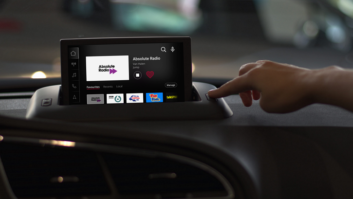The last couple of years have seen the rapid introduction of many new and improved digital flash recorders.
Part of the trend has been smaller-sized devices. Now, Yamaha has broken the weight and size barrier with a full linear PCM recorder weighing only 1.7 ounces and measuring a half-inch thick.
Yes, folks, full CD-quality 44.1 kHz, 16 bit WAV recording for up to three hours, 10 minutes, in a device the size of a typical voice recorder. The Pocketrak 2G is virtually weightless, easily pocketable and can go anywhere.
(click thumbnail)This is a $350 game-changer for radio reporters looking for not only the ultimate in size and portability, but a full-featured, well-built general purpose audio recorder in a black-laquered case measuring 4.5 inches long, 1.4 inches wide and a half inch thick. Best yet, it sounds good — very good.
Small wonder
Yamaha’s engineers did a remarkable job of marrying the right features in a recorder so small.
The Pocketrak 2G features a unique tilt-up stereo microphone that allows the recorder to rest on a table, yet one can record interviews and other audio without obstructions to the microphone. It also has a built-in, slide-out USB 2.0 connector that enables recordings to be transferred to easily Macintosh and PC computers for editing.
Though this tiny device can record more than nine hours in PCM mode (up to 19 hours for MP3) on a single AAA alkaline, the unit includes a new Sanyo “eneloop” battery that can be recharged via USB up to 1,000 times (90 min. charge time) and does not suffer self-discharge problems prevalent in earlier pocket-sized systems.
Anyone having had to change batteries frequently with previous voice recorders knows this is a major improvement in powering technology.
The Pocketrak 2G features a bright, backlit viewfinder with manual or automatic microphone level control. There’s also a built-in speaker, earphone jack and external switchable mic- or line-level input jack. A hard switch on the back of the recorder allows variable playback speed of plus or minus 25 percent.
The recorder features two gigabytes of internal flash memory, plus three MP3 modes (16 to 320 kbps) for extended recording of voice or music. In the lowest quality, mono MP3 mode, the recorder can record 266 hours.
There’s also a menu adjustment for setting a “clear voice” function to reduce noise, a three-way microphone sensitivity setting, voice-activated system recording, timer recordings, and when recording CDs, an auto divide function that senses sound divisions and divides tunes into separate files.
Index marks can be inserted into recordings. Up to 32 marks can be inserted while either recording or playing back files. This feature helps in locating segments quickly for sound bites from interviews or speeches.
Product CapsuleYamaha Pocketrak 2G
Thumbs Up

- Smallest full CD-quality audio recorder built; weighs 1.7 oz
- Excellent audio quality from built-in adjustable mic
- Built-in USB 2.0 jack, works with any personal computer
- Solid, easy-to-use software on backlight screen
- Reasonable $350 cost
Thumbs Down
- Because it is a music player as well as data storage device, the recorder offers many choices that unnecessarily clutter the interface with features.
Price
$350
Contact
www.yahamasynth.comIn addition to being used as a portable audio recorder, the Pocketrak 2G can be both a music and data recorder. Music files ripped on a computer in MP3 or WMA format are housed in a music folder and can be played back on the device. There’s even DRM 10 support. Data files, which also can be moved via USB, are stored in a data-only folder. Another folder houses MP3 files ripped from a CD player.
Certain folders can be password-protected for security. As a mass storage class device, the built-inch USB connector is simply plugged into any computer. It then shows up on the desktop as a storage device. Files can be dragged and dropped onto or from the icon.
Production
Included with the Pocketrak 2G is a licensed copy of Steinberg’s Cubase AI4 for both Macintosh and Windows. This is comprehensive music production software offering up to 48 simultaneous audio tracks and 64 MIDI tracks, plus a variety of VST plug-in software synths and effects, as well as full VSTi compatibility.
The “AI” in Cubase AI4 stands for Advanced Integration, and this new software delivers sophisticated functions and a high level of hardware/software integration.
This includes SoundFrame, an integrated feature built into Cubase AI4 that manages sounds, samples, presets and loops in one centralized database. There also are extensive editing capabilities.
The inclusion of the Cubase software indicates that perhaps the intended market for this recorder is musicians and composers. However, it’s hard to ignore the device’s potential for radio news and interviews. This is the smallest CD-quality audio recorder ever made and I suspect a wide range of users will be attracted to its capabilities.
There are certainly flash memory audio recorders with more features including digital I/O, such as Sony’s excellent PCM-D50. However, nothing on the market can compete with the Yamaha’s diminutive size. For portability, the Yamaha is the slam-dunk winner.
When we tested the tiny recorder we found the audio quality superb and the build-quality excellent. The little built-in stereo mic sounded fine, with precise bass and presence. The user interface was first-rate, making ease of operation very good. If I have a criticism, it’s that the recorder has too many features, trying to be something for everyone.
For a highly-portable audio recorder that can be carried virtually invisibly anywhere and everywhere, the Yamaha Pocketrak 2G is the new standard. Radio reporters should take note of this one.







